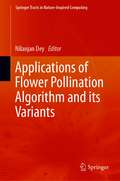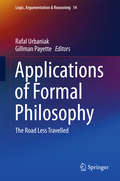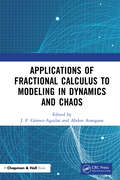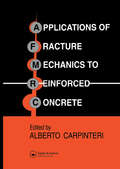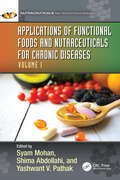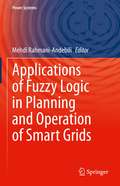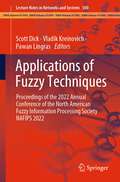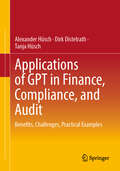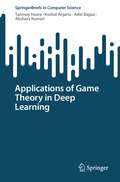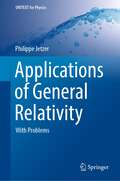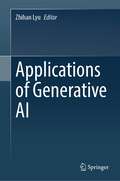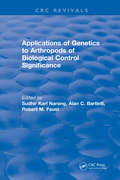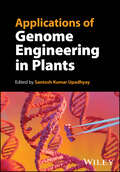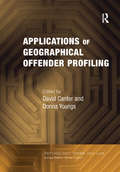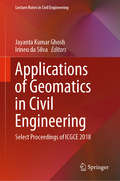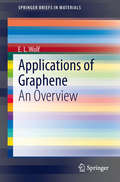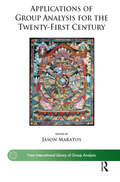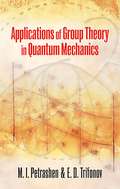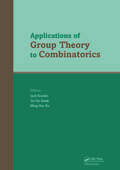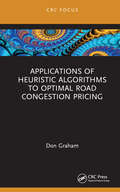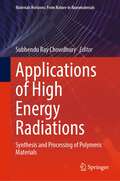- Table View
- List View
Applications of Flower Pollination Algorithm and its Variants (Springer Tracts in Nature-Inspired Computing)
by Nilanjan DeyThis book presents essential concepts of traditional Flower Pollination Algorithm (FPA) and its recent variants and also its application to find optimal solution for a variety of real-world engineering and medical problems. Swarm intelligence-based meta-heuristic algorithms are extensively implemented to solve a variety of real-world optimization problems due to its adaptability and robustness. FPA is one of the most successful swarm intelligence procedures developed in 2012 and extensively used in various optimization tasks for more than a decade. The mathematical model of FPA is quite straightforward and easy to understand and enhance, compared to other swarm approaches. Hence, FPA has attracted attention of researchers, who are working to find the optimal solutions in variety of domains, such as N-dimensional numerical optimization, constrained/unconstrained optimization, and linear/nonlinear optimization problems. Along with the traditional bat algorithm, the enhanced versions of FPA are also considered to solve a variety of optimization problems in science, engineering, and medical applications.
Applications of Fluid Dynamics: Proceedings of ICAFD 2016 (Lecture Notes in Mechanical Engineering)
by M. K. Singh B. S. Kushvah G. S. Seth J. PrakashThe book presents high-quality papers presented at 3rd International Conference on Applications of Fluid Dynamics (ICAFD 2016) organized by Department of Applied Mathematics, ISM Dhanbad, Jharkhand, India in association with Fluid Mechanics Group, University of Botswana, Botswana. The main theme of the Conference is "Sustainable Development in Africa and Asia in context of Fluid Dynamics and Modeling Approaches". The book is divided into seven sections covering all applications of fluid dynamics and their allied areas such as fluid dynamics, nanofluid, heat and mass transfer, numerical simulations and investigations of fluid dynamics, magnetohydrodynamics flow, solute transport modeling and water jet, and miscellaneous. The book is a good reference material for scientists and professionals working in the field of fluid dynamics.
Applications of Formal Philosophy: The Road Less Travelled (Logic, Argumentation & Reasoning #14)
by Rafał Urbaniak Gillman PayetteThis book features mathematical and formal philosophers' efforts to understand philosophical questions using mathematical techniques. It offers a collection of works from leading researchers in the area, who discuss some of the most fascinating ways formal methods are now being applied. It covers topics such as: the uses of probable and statistical reasoning, rational choice theory, reasoning in the environmental sciences, reasoning about laws and changes of rules, and reasoning about collective decision procedures as well as about action. Utilizing mathematical techniques has been very fruitful in the traditional domains of formal philosophy - logic, philosophy of mathematics and metaphysics - while formal philosophy is simultaneously branching out into other areas in philosophy and the social sciences. These areas particularly include ethics, political science, and the methodology of the natural and social sciences. Reasoning about legal rules, collective decision-making procedures, and rational choices are of interest to all those engaged in legal theory, political science and economics. Statistical reasoning is also of interest to political scientists and economists.
Applications of Fractional Calculus to Modeling in Dynamics and Chaos
by Abdon Atangana Gómez-Aguilar, J. F.Applications of Fractional Calculus to Modeling in Dynamics and Chaos aims to present novel developments, trends, and applications of fractional-order derivatives with power law and Mittag-Leffler kernel in the areas of chemistry, mechanics, chaos, epidemiology, fluid mechanics, modeling, and engineering. Non-singular and non-local fractional-order derivatives have been applied in different chapters to describe complex problems. The book offers theory and practical applications for the solutions of real-life problems and will be of interest to graduate-level students, educators, researchers, and scientists interested in mathematical modeling and its diverse applications. Features Discusses real-world problems, theory, and applications Covers new developments and advances in the various areas of nonlinear dynamics, signal processing, and chaos Suitable to teach master’s and/or PhD-level graduate students, and can be used by researchers, from any field of the social, health, and physical sciences
Applications of Fracture Mechanics to Reinforced Concrete
by Alberto CarpinteriThis volume emphazises the most recent advances in fracture mechanics as specifically applied to steel bar reinforced concrete. Fracture mechanics has been applied to plain and fibre reinforced concrete with increasing success over recent years. This workshop extended these concepts to steel bar reinforced and pre-stressed concrete design. Particularly for high strength concrete, which is a very brittle material, and in the case of large structural members, the application of fracture mechanics appears to be very useful for improving the present design rules. The pre-eminent participants at the Turin workshop contributed extensive expert opinions in four selected areas for which a rational approach, using fracture mechanics, could introduce variations into the concrete design codes: size effects; anchorage and bond; minimum reinforcement for elements in flexure; and shear resistance. The 23 chapters logically address these themes and demonstrate the unique ability of fracture mechanics to capture all the experimentally observed characteristics. The book is primarily directed to the researchers in universities and institutions and will be of value to consultants and engineering companies.
Applications of Functional Foods and Nutraceuticals for Chronic Diseases: Volume I (Nutraceuticals)
by Yashwant V. Pathak Syam Mohan Shima AbdollahiWhile disease is inevitable in humankind, the current century has been burdened with many chronic diseases, most of which are lifestyle mediated and, which in part can be controlled by consuming foods with specific functions. Functional foods are a special category of natural food or nutrient-derived pharmaceutical products containing beneficial biochemicals and phytochemicals beyond their basic nutritional functions. The first of two volumes, Applications of Functional Foods and Nutraceuticals for Chronic Diseases collects information on the association between functional and chronic diseases. The burden of escalating chronic diseases is discussed in the first chapter, and the remaining fourteen chapters summarize the effect of functional foods on a range of chronic diseases. Key Features: Discusses the clinical application of functional foods for the management of a wide range of chronic diseases Covers chronic diseases including Obesity, Arthritis, Cardiovascular Diseases, and Endocrinal and Hormonal Diseases, among others. Explores beneficial effects of nutraceuticals on chronic diseases Contributors hail from different geographical locations around the world and have many years of research and scholarly experience in functional foods, nutraceuticals, and biology. The world’s leading wellness centers for chronic diseases are using functional foods and nutraceuticals in their practice and discovering their useful applications, and this book is a great reference for practitioners, scientists, and clinicians in the management of chronic diseases.
Applications of Fuzzy Logic in Decision Making and Management Science (Information Systems Engineering and Management #29)
by Subrata Jana Anirban Sarkar Biswadip Basu Mallik Chiranjibe JanaThe fuzzy logic theory is a branch of mathematics dealing with uncertainty in measurement of any quantity or any estimation. The concept of fuzzy logic uses membership functions. The range of values from various functions or operations determines their construction. A defined rules set can create an application process and membership controls. Fuzzy applications include control system engineering, image processing, power engineering, industrial automation, robotics, consumer electronics and AI. Artificial intelligence, machine learning and expert systems have various applications that address complicated issues. The fuzzy logic inference rules have solved many problems in manufacturing and other industries. Auto engines by Honda, lift control by Mitsubishi Electric, palmtop computers by Hitachi, dishwashers by Matsushita and anti-lock brakes by Nissan are examples of corporations using machine-learning techniques with fuzzy principles. Fuzzy approaches and rule sets interpret computer vision, machine learning and evolution. Fuzzy sets can govern decision rules. Several areas use fuzzy systems in different ways. Computer vision, image processing and meta heuristic evolutionary computing are typical face research applications. Fuzzy theories can optimise and fine-tune the classifier model. Fuzzy theory is used in management, stock market analysis, information retrieval, linguistics, and behavioural science with good results. Fuzzy applications are seen in data mining and stock market prediction. The fuzzy machine learning model in the ensemble pattern accurately classifies and predicts all kinds of tasks. Fuzzy theories help maintain high accuracy. For categorisation and prediction, the ensemble pattern uses fuzzy concepts. The constant growth of fuzzy domain leads to several categorisation and prediction methods. Fuzzy type 2 and intuitionistic fuzzy logic exhibit promise accuracy and versatility. Such fuzzy logic variations can readily overcome the drawbacks of the simple fuzzy model. The book has been developed keeping in view about readers of different categories starting from the students to the professionals and researchers as well. The development of the book and its content layout will be done so meticulously proving the enough insights of the subjects to the readers so that the readers can easily pursue their research concept from the book. Overall the book serve as the purpose of repository of good amount of information and their technical presentations.
Applications of Fuzzy Logic in Planning and Operation of Smart Grids (Power Systems)
by Mehdi Rahmani-AndebiliFuzzy logic has vast applications in power and electrical engineering. This collection is the first book to cover research advancements in the application of fuzzy logic in the planning and operation of smart grids. A global group of researchers and scholars present innovative approaches to fuzzy-based smart grid planning and operation, cover theoretical concepts and experimental results of the application of fuzzy-based techniques, and define and apply these techniques to deal with smart grid issues. Applications of Fuzzy Logic in Planning and Operation of Smart Grids is an ideal resource for researchers on the theory and application of fuzzy logic, practicing engineers working in electrical power engineering and power system planning, and post-graduates and students in advanced graduate-level courses.
Applications of Fuzzy Techniques: Proceedings of the 2022 Annual Conference of the North American Fuzzy Information Processing Society NAFIPS 2022 (Lecture Notes in Networks and Systems #500)
by Pawan Lingras Vladik Kreinovich Scott DickThis book is of interest to practitioners, researchers and graduate students seeking to apply existing techniques, to learn about the state of the art, or to explore novel concepts, in the theory and application of fuzzy sets and logic. Human knowledge and judgement are essential in both designing technological systems and in evaluating their outcomes. However, humans think and communicate in imprecise concepts, not numbers. Fuzzy sets and logic are well-known, widely used approaches to bridging this gap, which have been studied for nearly 60 years. NAFIPS 2022 brought together researchers studying both the theoretical foundations of fuzzy logic and its application to real-world problems. Their work examined fuzzy solutions to problems as diverse as astronomy, chemical engineering, economics, energy engineering, health care, and transportation engineering. Many papers combined fuzzy logic with interval or probabilistic computing, neural networks, and genetic algorithms.
Applications of GPT in Finance, Compliance, and Audit: Benefits, Challenges, Practical Examples
by Alexander Hüsch Dirk Distelrath Tanja HüschThis book, authored by three experts with the assistance of GPT, provides comprehensive insights into the applications of generative AI, such as GPT, in the financial sector of businesses. It offers background information, benefits, as well as the challenges and risks associated with implementation. In addition to general applications within companies, specific use cases are also presented, focusing on areas such as controlling, business intelligence, accounting, investor relations, internal audit and control systems, risk management, auditing, and data privacy. The book concludes with a discussion on strategies for utilizing GPT effectively.
Applications of Game Theory in Deep Learning (SpringerBriefs in Computer Science)
by Tanmoy Hazra Kushal Anjaria Aditi Bajpai Akshara KumariThis book aims to unravel the complex tapestry that interweaves strategic decision-making models with the forefront of deep learning techniques. Applications of Game Theory in Deep Learning provides an extensive and insightful exploration of game theory in deep learning, diving deep into both the theoretical foundations and the real-world applications that showcase this intriguing intersection of fields. Starting with the essential foundations for comprehending both game theory and deep learning, delving into the individual significance of each field, the book culminates in a nuanced examination of Game Theory's pivotal role in augmenting and shaping the development of Deep Learning algorithms. By elucidating the theoretical underpinnings and practical applications of this synergistic relationship, we equip the reader with a comprehensive understanding of their combined potential. In our digital age, where algorithms and autonomous agents are becoming more common, the combination of game theory and deep learning has opened a new frontier of exploration. The combination of these two disciplines opens new and exciting avenues. We observe how artificial agents can think strategically, adapt to ever-shifting environments, and make decisions that are consistent with their goals and the dynamics of their surroundings. This book presents case studies, methodologies, and real-world applications.
Applications of General Relativity: With Problems (UNITEXT for Physics)
by Philippe JetzerThe aim of this textbook is to present in a comprehensive way several advanced topics of general relativity, including gravitational waves, tests of general relativity, time delay, spinors in curved spacetime, Hawking radiation, and geodetic precession to mention a few. These are all important topics in today's research activities from both a theoretical and experimental point of view. This textbook is designed for advanced undergraduate and graduate students to strengthen the knowledge acquired during the core courses on General Relativity. The author developed the book from a series of yearly lectures with the intention of offering a gentle introduction to the field. This book helps understanding the more specialized literature and can be used as a first reading to get quickly into the field when starting research. Chapter-end exercises complete the learning material to master key concepts.
Applications of Generative AI
by Zhihan LyuThis book provides a comprehensive introduction to Generative AI in terms of basic concepts, core technologies, technical architecture, and application scenarios. Readers gain a deeper understanding of the emerging discipline of Generative AI. This book covers the latest cutting-edge application technologies of Generative AI in various fields. It provides relevant practitioners with ideas to solve problems and deepen their understanding of Generative AI. At the same time, it guides and helps Generative AI and related industries to deepen their understanding of the industry and enhance professional knowledge and skills. Starting from reality, this book lists many cases and analyzes theories in a popular image. The book is useful for AI researchers and specifically for those working with the applications at hand (primarily medical imaging and construction/twinning industry). It covers a variety of cutting-edge technologies in Generative AI, which provides researchers with new research ideas.
Applications of Genetics to Arthropods of Biological Control Significance
by Sudhir Karl NarangWritten by experts in the fields of insect pest genetics, the genetics of biological control organisms, and the application of biological control, this book provides the first up-to-date summary of the genetic literature on the genetics of arthropod biological control agents. It identifies successful programs and also gaps and needs in research, research constraints, and possible research approaches in this important field of pest control. The power and applicability of new genetic and molecular biology methods have created new and exciting possibilities to greatly improve the effectiveness of traditional biological control programs. This book provides essential information about the state-of-the-art application of these new methods. It explains how biological control procedures can be improved, covers methods for selecting pesticide-resistant strains of natural enemies, and looks at methods for maintaining genetic diversity and quality control during the rearing of biological control agents in the laboratory. The book also provides information regarding the application of powerful PCR methods for taxonomic identification of strains and species of biocontrol agents.
Applications of Genome Engineering in Plants
by Santosh Kumar UpadhyayApplications of Genome Engineering in Plants Understand the keys to creating the food of the future Genome engineering in plants is a field that has made enormous strides in recent years. In particular, the CRISPR-Cas system has been used in a number of crop species to make significant leaps forward in nutritional improvement, stress tolerance, crop yield, and more. As scientists work to meet global food needs and foster sustainable agriculture in a changing world, genome engineering promises only to become more important. Applications of Genome Engineering in Plants details the history of, and recent developments in, this essential area of biotechnology. It describes advances enabling nutritional improvement, nutraceuticals improvement, flavonoid enrichment, and many more crop enhancements, as well as subjects such as biosafety and regulatory mechanisms. The result is a thorough and essential overview for researchers and biotech professionals. Applications of Genome Engineering in Plants readers will also find: Chapters on trans-gene free editing or non-transgenic approaches to plant genomes Detailed discussion of topics including nanotechnology-facilitated genome editing, engineering for virus resistance in plants, and more Applications of genome editing in oil seed crops, vegetables, ornamental plants, and many others Applications of Genome Engineering in Plants is ideal for academics, scientists, and industry professionals working in biotechnology, agriculture, food science, and related subjects.
Applications of Geographical Offender Profiling (Psychology, Crime and Law)
by Donna YoungsMany law enforcement agencies are now analyzing where a crime is committed, to develop predictions on the offender, their location and other factors that could help with the investigation. Known as Geographical Offender Profiling (GOP), this approach relies on a combination of principles and methodologies drawn from many different disciplines, including psychology, geography, criminology and forensic science. This book brings together a cross-section of the major papers published in the field of GOP to explain the scope and application of GOP in different criminal contexts. For the first time some widely quoted but difficult to obtain 'classic' papers have been published together with an introduction that provides an up-to-the-minute context and an extensive bibliography of the most relevant publications in this burgeoning area of study.
Applications of Geomatics in Civil Engineering: Select Proceedings of ICGCE 2018 (Lecture Notes in Civil Engineering #33)
by Jayanta Kumar Ghosh Irineu Da SilvaThis book comprises select proceedings of the First International Conference on Geomatics in Civil Engineering (ICGCE 2018). This book presents latest research on applications of geomatics engineering in different domains of civil engineering, like structural engineering, geotechnical engineering, hydraulic and water resources engineering, environmental engineering and transportation engineering. It also covers miscellaneous applications of geomatics in a wide range of technical and societal problems making use of geospatial information, engineering principles, and relational data structures involving measurement sciences. The book proves to be very useful for the scientific and engineering community working in the field of geomatics and geospatial technology.
Applications of Graphene: An Overview (SpringerBriefs in Materials)
by E. L. WolfGraphene is presented and analyzed as a replacement for silicon. The Primary focus is on solar cell and CMOS device technologies, with attention to the fabrication methods, including extensions needed, in each case. Specialized applications for graphene within the existing silicon technology are discussed and found to be promising.
Applications of Green's Functions in Science and Engineering (Dover Books on Engineering)
by Michael D. GreenbergConcise and highly regarded, this treatment of Green's functions and their applications in science and engineering is geared toward undergraduate and graduate students with only a moderate background in ordinary differential equations and partial differential equations. The text also includes a wealth of information of a more general nature on boundary value problems, generalized functions, eigenfunction expansions, partial differential equations, and acoustics. The two-part treatment begins with an overview of applications to ordinary differential equations. Topics include the adjoint operator, delta function, the Green's function method, and the eigenfunction method. The second part, which explores applications to partial differential equations, covers functions for the Laplace, Helmholtz, diffusion, and wave operators. A full index, exercises, suggested reading list, a new preface, and a new brief errata list round out the text.
Applications of Group Analysis for the Twenty-First Century: Applications (The New International Library of Group Analysis)
by Jason MaratosThe Institute of Group Analysis (IGA) celebrates forty years from its foundation with the publication of these two volumes. The first volume aims to publicise the foundations of group analysis (with the earliest papers of Foulkes) as well as the most influential theoretical contributions by pillars of modern group analysis, such as Pines, Brown, and Hopper. The reader will be able to see the development of Group Analysis, form an opinion about the trajectory that it follows, and judge which way the tradition of openness and creative integration of diverse theoretical contributions will lead in the twenty-first century. The second volume focuses on the numerous fields of work that use group analytic principles. Workers in the field of forensic psychotherapy would now consider a great omission if they did not use some form of group analytic intervention, as would professionals dealing with those who manifest personality disorders or different age groups, such as adolescents. Group analysis has made significant contribution to organisational work, to feminism and anti-discrimination (including anti-racism) as well as in education.
Applications of Group Theory in Quantum Mechanics (Dover Books on Physics)
by M. I. Petrashen J. L. TrifonovGeared toward postgraduate students, theoretical physicists, and researchers, this advanced text explores the role of modern group-theoretical methods in quantum theory. The authors based their text on a physics course they taught at a prominent Soviet university. Readers will find it a lucid guide to group theory and matrix representations that develops concepts to the level required for applications.The text's main focus rests upon point and space groups, with applications to electronic and vibrational states. Additional topics include continuous rotation groups, permutation groups, and Lorentz groups. A number of problems involve studies of the symmetry properties of the Schroedinger wave function, as well as the explanation of "additional" degeneracy in the Coulomb field and certain subjects in solid-state physics. The text concludes with an instructive account of problems related to the conditions for relativistic invariance in quantum theory.
Applications of Group Theory to Atoms, Molecules, and Solids
by Thomas Wolfram nas Ell altio luThe majority of all knowledge concerning atoms, molecules, and solids has been derived from applications of group theory. Taking a unique, applications-oriented approach, this book gives readers the tools needed to analyze any atomic, molecular, or crystalline solid system. Using a clearly defined, eight-step program, this book helps readers to understand the power of group theory, what information can be obtained from it, and how to obtain it. The book takes in modern topics, such as graphene, carbon nanotubes and isotopic frequencies of molecules, as well as more traditional subjects: the vibrational and electronic states of molecules and solids, crystal field and ligand field theory, transition metal complexes, space groups, time reversal symmetry, and magnetic groups. With over 100 end-of-chapter exercises, this book is invaluable for graduate students and researchers in physics, chemistry, electrical engineering and materials science.
Applications of Group Theory to Combinatorics
by Jin Ho Kwak Jack Koolen Ming-Yao XuApplications of Group Theory to Combinatorics contains 11 survey papers from international experts in combinatorics, group theory and combinatorial topology. The contributions cover topics from quite a diverse spectrum, such as design theory, Belyi functions, group theory, transitive graphs, regular maps, and Hurwitz problems, and present the state
Applications of Heuristic Algorithms to Optimal Road Congestion Pricing
by Don GrahamRoad congestion imposes major financial, social, and environmental costs. One solution is the operation of high-occupancy toll (HOT) lanes. This book outlines a method for dynamic pricing for HOT lanes based on non-linear programming (NLP) techniques, finite difference stochastic approximation, genetic algorithms, and simulated annealing stochastic algorithms, working within a cell transmission framework. The result is a solution for optimal flow and optimal toll to minimize total travel time and reduce congestion. ANOVA results are presented which show differences in the performance of the NLP algorithms in solving this problem and reducing travel time, and econometric forecasting methods utilizing vector autoregressive techniques are shown to successfully forecast demand. The book compares different optimization approaches It presents case studies from around the world, such as the I-95 Express HOT Lane in Miami, USA Applications of Heuristic Algorithms to Optimal Road Congestion Pricing is ideal for transportation practitioners and researchers.
Applications of High Energy Radiations: Synthesis and Processing of Polymeric Materials (Materials Horizons: From Nature to Nanomaterials)
by Subhendu Ray ChowdhuryThis book presents the applications of high-energy beam radiation for synthesis and processing of polymeric materials. It addresses fundamental nature of high energy i.e., ionizing radiations and interaction with monomers and polymers leading to a wide variety of products such as tyres, textiles, shape memory polymers, polymers for aviation and space applications, polymeric biomaterials and natural rubber latex. It discusses general principles and techniques of preparation of polymeric materials including polymer blends, composites and nanocomposites. It also includes the topic of radiation-assisted recycling of polymers through breaking of covalent bonds. This book will be useful for students, researchers and professionals in the areas of polymers science and technology, radiation technology, electron beam technology, gamma radiation technology, advanced materials technology, biomaterials technology, nanotechnology, membrane science technology and environmental science.
